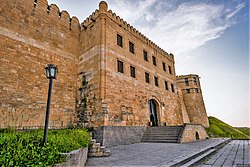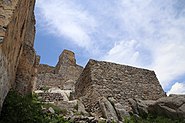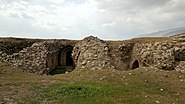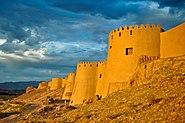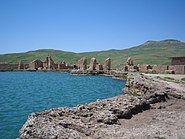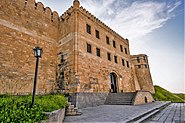
Derbent, formerly romanized as Derbend, is a city in Dagestan of Russia, located on the Caspian Sea. It is the southernmost city in Russia, and it is the second-most important city of Dagestan. Derbent occupies the narrow gateway between the Caspian Sea and the Caucasus Mountains connecting the Eurasian Steppe to the north and the Iranian Plateau to the south; covering an area of 69.63 square kilometres (26.88 sq mi), with a population of roughly 120 thousand residents.

Dagestan, officially the Republic of Dagestan, is a republic of Russia situated on the Caspian Sea, in the North Caucasus of Eastern Europe. It is located north of the Greater Caucasus, and is a part of the North Caucasian Federal District. As the southernmost tip of Russia, the republic shares land borders with the countries of Azerbaijan and Georgia to its south and southwest; and borders the Russian republics of Chechnya and Kalmykia to its west and north, while having a border with Stavropol Krai to its northwest. Makhachkala is the capital and largest city; other chief cities are Derbent, Kizlyar, Izberbash, Kaspiysk and Buynaksk.
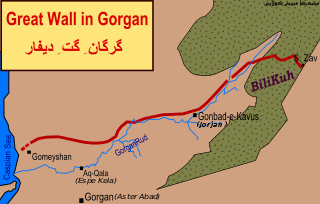
The Great Wall of Gorgan is a Sasanian-era defense system located near modern Gorgan in the Golestān Province of northeastern Iran, at the southeastern corner of the Caspian Sea. The western, Caspian Sea, end of the wall is near the remains of the fort at: 37.13981°N 54.1788733°E; the eastern end of the wall, near the town of Pishkamar, is near the remains of the fort at: 37.5206739°N 55.5770498°E. The title coordinate is for the location of the remains of a fort midway along the wall.

Tahmasp II (1704? – 11 February 1740) was one of the last Safavid rulers of Persia (Iran).

The Gates of Alexander was a legendary barrier supposedly built by Alexander the Great in the Caucasus to keep the uncivilized barbarians of the north from invading the land to the south. The gates were a popular subject in medieval travel literature, starting with the Alexander Romance in a version from perhaps the 7th century.

The Russo-Persian War of 1722–1723, known in Russian historiography as the Persian campaign of Peter the Great, was a war between the Russian Empire and Safavid Iran, triggered by the tsar's attempt to expand Russian influence in the Caspian and Caucasus regions and to prevent its rival, the Ottoman Empire, from territorial gains in the region at the expense of declining Safavid Iran.
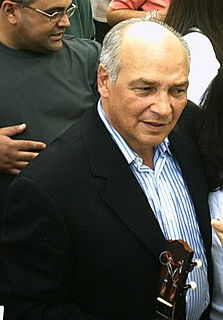
Hernan José Gamboa Alexis, better known as Hernan José Gamboa Alexis was a Venezuelan musician, composer and singer. He was a member of the Venezuelan fold music group Serenata Guayanesa, and later released separate albums.

Petróleos del Perú(Petroperú), is a Peruvian state-owned company and private law dedicated to the transportation, refining, distribution and commercialization of fuels and other petroleum petroleum products. This company belonging to the Peruvian State since 1969, is considered among the main taxpayers to the treasury and currently employs more than 2,500 people. On the other hand, it makes important investments in education, health and other sustainable development projects throughout the Peruvian territory. Among the current strategic objectives of the company are the supply of fuel to the entire Peruvian market, as well as financial sustainability and its operations, with a special emphasis on safety and care for the environment.

Candeleda is a town and municipality located in the province of Ávila, in the autonomous community of Castile and León, Spain. According to the 2011 INE census, the municipality has a population of 5,213 inhabitants, making it the fifth largest municipality in the province after Ávila –the capital–, Arévalo, Arenas de San Pedro and Las Navas del Marqués. The town is located on the southern hillside of the Gredos mountains, 432 m above sea level, giving it a microclimate with a thermal regime of mild winters and hot summers and average summer temperatures of 26 °C.

Oliete is a municipality located in the province of Teruel, Aragon, Spain. According to the 2017 census (INE), the municipality has a population of 357 inhabitants.

The Russian conquest of the Caucasus mainly occurred between 1800 and 1864. In that era the Russian Empire expanded to control the region between the Black Sea and Caspian Sea, the territory that is modern Armenia, Azerbaijan, Georgia, and parts of Iran and Turkey, as well as the North Caucasus region of modern Russia. Multiple wars were fought against the local rulers of the regions, as well as the dominant powers, the Ottoman Empire and Persian Empire, for control. By 1864 the last regions were brought under Russian control.

Evelio Arias Ramos was a Mexican actor, comedian and singer.
Iranian Russians or Persian Russians are Iranians in the Russian Federation, and are Russian citizens or permanent residents of (partial) Iranian national background.
The Second relation letter from Hernán Cortés to emperor Charles V is one of the five Letters of relation written by Hernán Cortés to Charles V, Holy Roman Emperor by his name in the Holy Roman Empire, and to his mother, the queen Joanna of Castile in which he relates his trips to Mexico and the conquest of Mexico-Tenochtitlán. This second letter was dated on 30 October 1520.

Paula Ortiz Álvarez is a Spanish director, screenwriter and producer who works for Get in the Pictures Productions and Amapola Films, teaches Audiovisual Communication at the University of Barcelona, and collaborates with the University of San Jorge in Zaragoza.

Thomas of Zumárraga and Lazcano was a Roman Catholic Missionary from Spain. He was beatified in May 1867 by Pope Pius IX.

Margarita Pisano Fischer was a Chilean architect, writer, theoretician, and feminist belonging to the Movimiento Rebelde del Afuera.

The defense lines of the Sasanians were part of their military strategy and tactic. They were networks of fortifications, walls, and/or ditches built opposite the territory of the enemies. These defense lines are known from tradition and archaeological evidence.
Kevin Wormald, is a Chilean weightlifter who currently competes in the -85 kg and -93 kg category. He started competing in 2010, being the 5th best athlete nationwide in the -56 kg category and under the tutelage of prominent lifter Cristián Escalante.
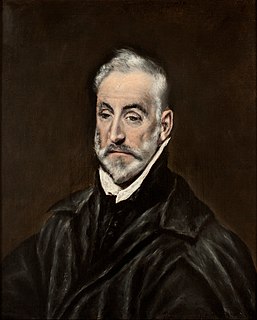
Portrait of Antonio de Covarrubias is a 1595-1600 oil on canvas painting by El Greco, dating to his time in Toledo. It is now in the Louvre in Paris as the result of an exchange with Spanish museums in 1941.
